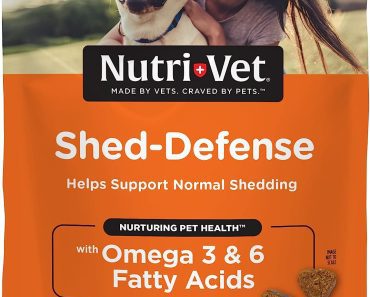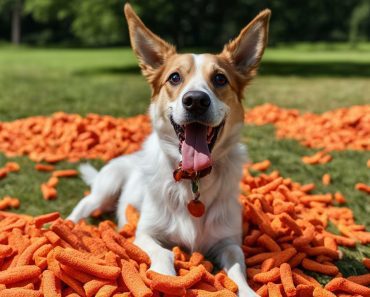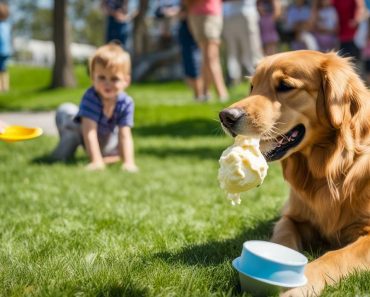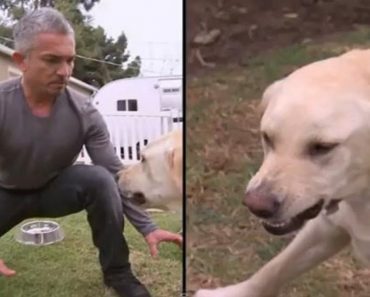I recently came across the question: Can dogs eat sugar snap peas? As a dog lover and concerned pet owner, I wanted to find out the answer, so I did some research.
Here’s what I discovered: sugar snap peas are safe for dogs to eat as an occasional treat. They are not toxic or poisonous to dogs and can be included in their diet. However, there are a few things to keep in mind when feeding peas to your furry friend.
Can Dogs Eat Sugar Snap Peas? Yes, as a once in a while snack.
- Sugar snap peas are safe for dogs to eat as an occasional treat.
- Canned peas should be avoided due to the high sodium content.
- Pea pods can be a choking hazard, so it’s important to remove them before feeding.
- Peas are rich in vitamins, minerals, protein, and fiber, making them a nutritious option for dogs.
- Dogs with kidney problems should avoid peas, as they contain purines that can lead to kidney stones.
Peas as a Source of Nutrition for Dogs
Peas can be a valuable addition to a dog’s diet, providing a range of essential nutrients. They are rich in vitamins such as vitamin A, K, and various B vitamins, including folate. Peas also contain important minerals like iron, zinc, potassium, and magnesium.
In addition to vitamins and minerals, peas are high in protein and fiber. Protein is crucial for muscle development and repair, while fiber supports healthy digestion and regular bowel movements.
One notable nutrient found in peas is lutein, which has been linked to improvements in skin, heart, and eye health. Lutein acts as an antioxidant and helps protect cells from damage caused by free radicals.
While dogs do not necessarily require fruits and vegetables in their diet like humans do, incorporating peas can provide additional nutritional benefits. Peas are low in calories, making them a suitable option for dogs who need to lose or maintain a healthy weight.
However, it is important to remember that dogs are primarily carnivores and require a diet primarily consisting of meat. Peas should only be given as a supplement to their regular food to ensure their nutritional needs are met. Consulting with a veterinarian can help determine the appropriate portion size and frequency of pea consumption for a dog.
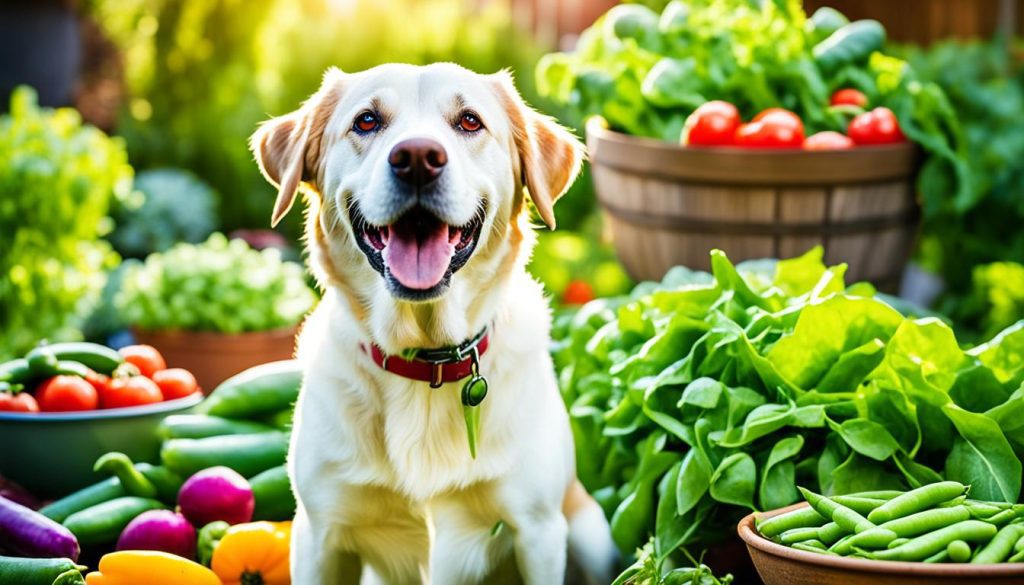
How to Safely Feed Peas to Dogs
When it comes to feeding peas to dogs, there are a few important considerations to keep in mind. Following these guidelines will ensure that your furry friend can enjoy sugar snap peas as a safe and nutritious treat.
Cooked Peas are Easier to Digest
Raw peas can be difficult for dogs to digest. To make peas more easily digestible for your pet, it’s best to cook them before serving. Whether you use fresh, frozen, or thawed peas, a quick cooking process will help break down the peas, making them more accessible for your dog’s digestive system.
Avoid Canned Peas
While fresh and frozen peas are safe for dogs to eat, canned peas should be avoided. Canned peas often contain added sodium, which can be harmful to your pet’s health. Stick to fresh or frozen peas to ensure your dog is getting the full nutritional benefits without the added sodium.
Remove Pea Pods
Pea pods can present a choking hazard for dogs, especially those who tend to eat their food quickly without proper chewing. To prevent any choking incidents, it’s important to remove the pea pods before feeding peas to your dog. Alternatively, you can choose to avoid giving pea pods altogether to eliminate the risk entirely.
Introduce Peas Gradually
When introducing peas to your dog’s diet, start with a small amount and gradually increase the serving size over time. This allows you to monitor any adverse reactions or digestive issues that may arise. If your dog shows any signs of discomfort or adverse reactions, consult with your veterinarian.
Follow the 10% Rule
As with any treats or additions to your dog’s diet, it’s important to follow the 10% rule. Treats, including sugar snap peas, should make up no more than 10% of your dog’s daily calorie intake. This ensures that your dog’s overall diet remains balanced and maintains their optimal health.
By following these simple guidelines, you can safely incorporate sugar snap peas into your dog’s diet as a healthy and nutritious treat. Remember to always prioritize your pet’s well-being and consult with your veterinarian if you have any concerns.
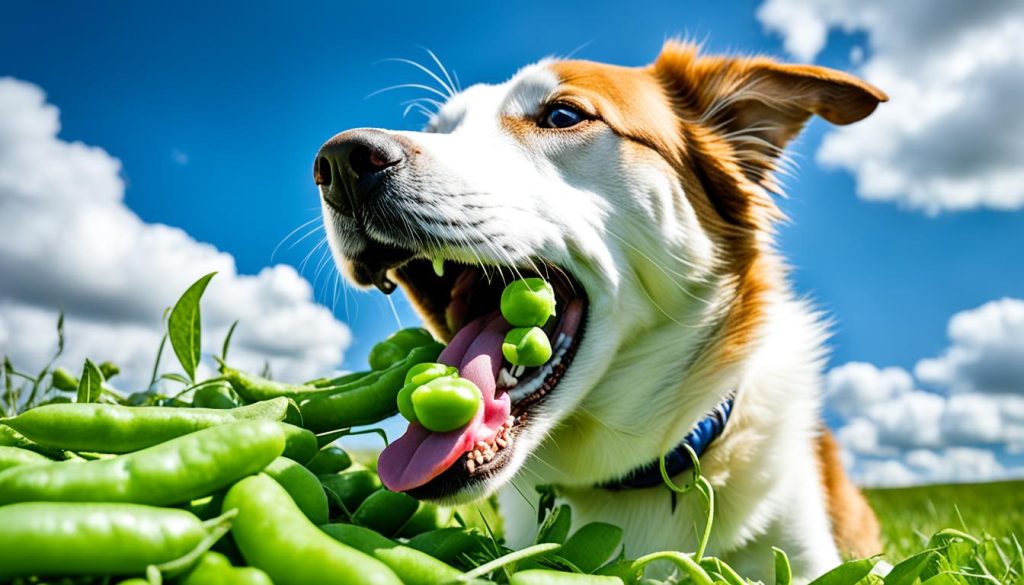
The Nutritional Value of Peas for Dogs
Peas offer a wealth of nutritional benefits for dogs, making them a valuable addition to their diet. Not only are peas rich in vitamins, such as vitamin A, vitamin C, and various B vitamins, but they also contain essential minerals like iron and magnesium. Additionally, peas serve as a good source of dietary fiber, contributing to a healthy digestive system for our furry friends.
Including peas in a dog’s diet can provide a variety of health benefits. The antioxidants and phytonutrients found in peas support a dog’s immune system, helping to keep them strong and protected against common illnesses. Furthermore, the low-calorie nature of peas makes them an excellent choice for dogs looking to lose weight or maintain a healthy weight.
However, it is crucial to note that dogs with kidney problems should avoid peas due to their purine content, which can exacerbate kidney issues. As with any new element introduced to a dog’s diet, it is best to consult with a veterinarian to ensure that peas are suitable for your dog’s specific nutritional needs.
Overall, peas offer valuable nutritional value to dogs, including vital vitamins, minerals, and fiber. They can contribute to a well-rounded and balanced diet for our canine companions. With proper consideration and moderation, incorporating peas into a dog’s diet can enhance their overall well-being and nutritional intake.
Overcoming Concerns About Feeding Peas to Dogs
As a pet owner, you may have concerns about feeding peas to your dogs. Let’s address some common worries and provide reassurance.
The Potential Choking Hazard
One concern is the potential choking hazard posed by pea pods. While it’s true that pea pods can be a choking risk for dogs, this can easily be avoided. Simply remove the pods or ensure they are not given to your furry friend. By taking this precaution, you can eliminate the risk and safely incorporate peas into your dog’s diet.
The Purines Found in Peas
Another concern is the presence of purines in peas. It’s important to note that dogs with kidney problems should avoid peas due to their purine content. However, for healthy dogs, the purine levels in peas are not a significant concern. As long as your dog doesn’t have any pre-existing kidney issues, they can enjoy the nutritional benefits of peas without worry.
The Need for Fruits and Vegetables in a Dog’s Diet
Many pet owners wonder if dogs really need fruits and vegetables in their diet. While dogs primarily thrive on a carnivorous diet, incorporating vegetables like sugar snap peas can provide added nutrition. While not essential, vegetables can serve as a healthy and low-calorie treat for your canine companion.
Remember, moderation is key. Peas should be given to your dog as an occasional treat and not as a substitute for their regular meals. By following these guidelines, you can overcome any concerns and confidently include peas in your dog’s diet for added pet nutrition.
Conclusion
Sugar snap peas can be a safe and nutritious addition to a dog’s diet. These vegetables are packed with vitamins, minerals, protein, and fiber, providing valuable nutrients that can benefit dogs’ overall health.
However, it’s important to exercise caution when feeding peas to dogs. Canned peas should be avoided due to their high sodium content, which can be harmful to dogs. Additionally, pea pods can pose a choking hazard, and it’s crucial to remove them before offering peas to your furry friend.
While dogs primarily thrive on a carnivorous diet, incorporating vegetables like sugar snap peas as an occasional treat can provide added nutrition. Peas can be cooked and served fresh, frozen, or thawed, making them suitable options for dogs.
As always, it’s essential to monitor your dog’s reaction to new foods and consult with a veterinarian if you have any concerns about their diet. By following these guidelines, you can ensure that your dog enjoys the benefits of sugar snap peas while maintaining a balanced and healthy diet.

